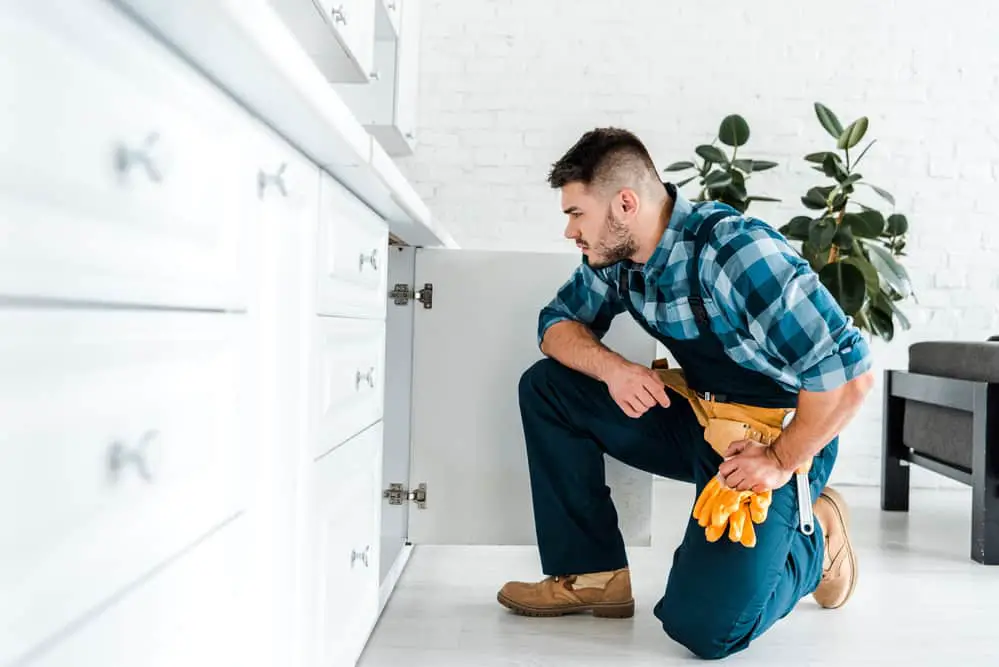Caulking is an important step in painting.
Many people often overlook caulking when painting furniture such as cabinets and other parts of the home.
Plenty of these people do so because of a lack of knowledge on whether to caulk before or after painting. We’re helping you master it right.
So let’s start with the question: Should You Caulk Kitchen Cabinets Before or After Painting?
Both are okay. Generally, it is advisable to caulk kitchen cabinets before painting. This is usually the case if the caulk line is visible afterward. And you can also caulk after painting. The bottom line is that caulking helps to seal cabinets and keep them in proper conditions and setting for a long time.
This blog post will guide you on how to caulk and other related ideas, including the best caulking materials and tips.
What Are the Benefits of Caulk?
1. Caulking Helps to Seal Gaps and Cracks
The main reason why caulking is done on furniture such as cabinets is to seal any cracks and gaps that often develop on wooden furniture over time.
2. To Prevent Entry of Moisture into The Cabinets
As we mentioned earlier, caulk seals off gaps and cracks. If they are not sealed, water can find its way into the cabinets and destroy them.
Caulking also prevents the entry of water into the walls. Water can equally damage the walls and foundation of the building and put the occupants at grave risk.
3. Caulking Prevents Pests’ Infestation
Caulked cabinets and furniture are protected from invading pests.
One thing about pests is that they love finding and creating homes in cracks and gaps.
Once they settle in such spots, they multiply and pose disastrous consequences to the occupants of the room and property alike. Caulking makes it impossible for them to find a place to settle.
Three Things to Consider Before Caulking Kitchen Cabinets
Just like any other interior repair and maintenance job, caulking should be given all the attention it deserves.
You want to make sure you do an excellent job. Certain things to put in place as you prepare to caulk your kitchen cabinets. They include:
1. Nature of the Surface
Kitchen cabinets are made of different materials. Wood is the most preferred one.
When applying caulk on wooden cabinets, make sure it is cleaned before work kicks off. A clean surface adheres well with caulk. More on this later
2. Choice of Paint to Use On-site
Certain paints do not adhere pretty well over caulk.
That is why you might need to paint first before caulking in such scenarios. Other colors adhere strongly to caulked surfaces and should not bother you.
All you have to do to avoid this confusion is consults with experts on the type of caulk you need for your kitchen cabinets and the kind of paint with that particular caulk.
Luckily, most caulking materials have more paraphrased guidelines on the type of paints recommended and whether they should be applied before or after caulking.
3. Caulk Type



These two broad types of caulk: are paintable and non-paintable caulk.
Your kitchen cabinets will require a new coat of paint as soon as you are done with caulking. You should, therefore, apply paintable caulk to your kitchen cabinets.
Paint gives your cabinets an ambient look. You cannot afford to lose it.
Non-paintable caulk is made of silicon making it impossible for the paint to adhere to it.
So make no mistake using silicon caulk on your kitchen cabinets because you will need to apply paint later.
Seven Timely Tips for Caulking Kitchen Cabinets
Unless you have done it before, you need a guide to guarantee a successful caulking experience. This guide is indispensable for your caulking experience.
This section will give you a hassle-free manual to get your job done fast and effectively.
1. For Cracks, Apply Up to 0.5-Inch Length.
Caulk is primarily applied to seal up cracks and gaps. You want to ensure that every attempt is sealed up to extend the durability of your kitchen cabinets.
That is why increasing the concentration and the area covered is essential.
2. Thoroughly Clean the Area You Want to Caulk
As you would do before painting any surface, ensure that your cabinets are rid of any dirt.
Similarly, caulk does not adhere to dirty and dusty surfaces.
So, make sure that the site is properly cleaned. A primer coat is applied on the site before you execute caulking.
3. Paint Wooden Surfaces First
Caulk sticks pretty well on wooden surfaces.
Paint surfaces are a substitute for a primer coat.
You may not get credible results if you try to apply caulk on plain wooden kitchen cabinets. It may start peeling off as soon as you are done.
4. Cut A Small Hole On the Tip of the Caulk Tube
Do not get tempted to apply too much caulk to the cabinets.
Simply use a small amount on the site by cutting a small hole in the caulk tube.
If you apply too much caulk, the surfaces become uneven and waste too much of your caulk. Not to mention that it may later become an issue during painting.
5. If You Are Using a Caulk Gun, Do So Gently and Slowly
Moving the caulk gun at the same ate ensures that the caulk is evenly applied right from the starting point.
Uneven application of caulk on kitchen cabinets makes them look weird. This can be noticeable even after painting.
6. Do Not Apply Caulk Over Wet Cabinets
If the cabinets are wet, there is every chance that mold and mildew have developed on the previous caulk.
You need to eradicate these molds and mildew by cleaning and dry the surface. Molds and mildew are not the only major concern here. Caulk does not quite adhere to wet surfaces.
7. Clean Up After Caulking
Of course, this is a rule of thumb after all painting, caulking, and construction work. It is important to remain mess-free after caulking.
Wipe your hands using a damp cloth. On the caulked cabinets, use a caulk-smoothing tool to clean any spouts and help maintain the cabinets sparkling clean.
Wrapping it Up
Caulking reinforces painting. It keeps your cabinets tidy. It also extends their durability.
You should never take it for granted.
Knowing the kind of materials that match with certain caulk is one thing.
The other is to understand how to apply caulk on these surfaces.
If you bump into problems doing this right, it is advisable to seek professional caulking services.
Hopefully, this article has helped shed light on everything you need to know about caulking.

